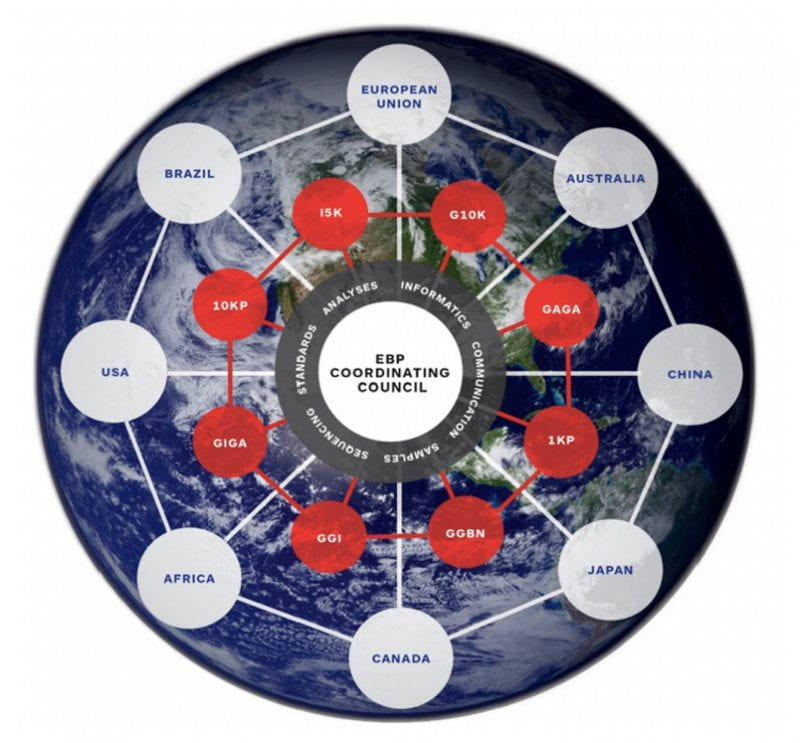Halmos College Joins in Illuminating Earth’s Biodiversity

 Following the pioneering footsteps of biodiversity giants EO Wilson and Thomas Lovejoy, the Earth BioGenome Project (EBP) was launched to create a “network of networks” with sights on sequencing the genomes of a majority of the earth’s living organisms. The overall goal of the venture is to read the complete genomes of about 1.8 million species of macro-organisms on the planet, encompassing all of the known species of mammals, reptiles, fishes, insects, trees flowers, mushrooms, and single-celled protists. The plan requires a hierarchical approach and known classification, identifying organisms that include Phyla, Classes, Families to finally reach the known species of living organisms represented by samples that people can collect and archive. Agreement on uniform sequencing standards and other consortia, such as the quality of sequence data, is important before addition to the EBP list. All these points have now been expounded, compilated, and published in a new set of papers in the Proceedings of National Academy of Sciences (PNAS) this week.
Following the pioneering footsteps of biodiversity giants EO Wilson and Thomas Lovejoy, the Earth BioGenome Project (EBP) was launched to create a “network of networks” with sights on sequencing the genomes of a majority of the earth’s living organisms. The overall goal of the venture is to read the complete genomes of about 1.8 million species of macro-organisms on the planet, encompassing all of the known species of mammals, reptiles, fishes, insects, trees flowers, mushrooms, and single-celled protists. The plan requires a hierarchical approach and known classification, identifying organisms that include Phyla, Classes, Families to finally reach the known species of living organisms represented by samples that people can collect and archive. Agreement on uniform sequencing standards and other consortia, such as the quality of sequence data, is important before addition to the EBP list. All these points have now been expounded, compilated, and published in a new set of papers in the Proceedings of National Academy of Sciences (PNAS) this week.
Halmos College of Arts and Sciences Department of Biological Sciences faculty member Jose (Joe) Lopez, Ph.D., plunged into this large-scale genome endeavor in 2013, with his co-founding of the Global Invertebrate Genomics Alliance (GIGA). Partially inspired by the earlier Genome10K project started by NSU HCAS professor, Stephen J. O’Brien, Ph.D., the GIGA community of scientists focuses solely on aquatic animals without spines (“invertebrates”) and recently became a non-profit entity. Lopez represents GIGA in the EBP network and is a member of the working group and co-author on three of the new PNAS papers. Lopez is also helping contribute up to 50 invertebrate species samples, including soft corals from local Broward coral reefs, for genome sequencing through the related Aquatic Symbiosis Genome (ASG) project in conjunction with the Darwin Tree of Life (DToL) program at the Wellcome Sanger Institute in the UK. Lopez works closely with Mark Blaxter, Ph.D. Program leader for the DToL program and lead author on the PNAS paper “Why sequence all eukaryotes?”
“It has been an honor to serve with a distinguished group of scientists dedicated to the genome sciences,” says Lopez. “The EBP poses clearly ambitious and non-trivial goals. But we have to start somewhere, and often basic science has to be done before we move to more specialized applications. Because the genomes of the planet’s organisms are all different (leading to biodiversity) due to evolution, they can provide answers to speciation/extinction, conservation, better health and how organisms interact symbiotically. The genomes also hold the potential for discovery of treatments for human disease. The sequencing effort is already bringing diverse scientists from different institutions and countries together toward a common goal and should be supported widely. Obtaining funding, such as convincing NSF to support the mega projects, presents a steep hill to climb. But we do need to take up the challenge, or else other countries will leap-frog ahead of us.”
Posted 01/30/22